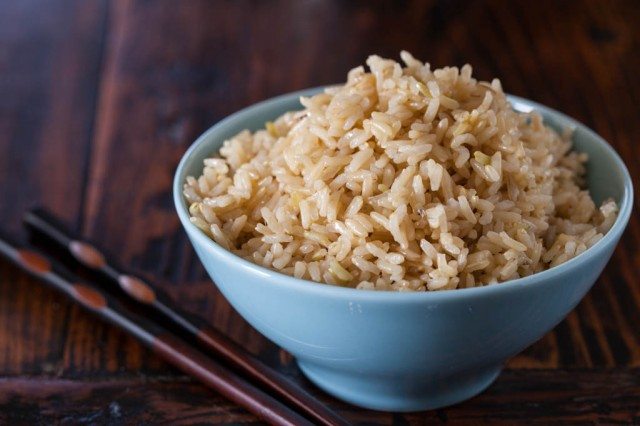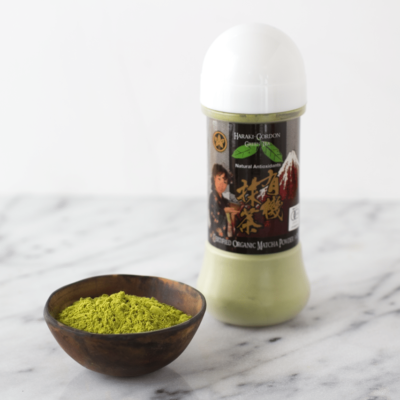Having food poisoning one time caused me to revert to my white-starch-eating childhood ways. I had regular old Uncle Ben’s instant rice for the first time in…..I don’t even remember the last time. And lemme tell you….
Plain old instant rice…. *shakes her head*
I swear, I made this stuff today and the ONLY good thing about it was that it was fast. Because it had been so long since I’ve had anything but brown or wild rice, I had no basis for comparison back when I used to eat it. But just a few bites in and I was convinced – instant white rice is completely worthless.
(My recipe for super easy, super awesome wild rice below!)
So I wondered, what is different in the processing that allows it to cook so fast and yet taste so terrible? Was this just another case of “Americanized” food created to be fast and easy without regard to quality? Well, in a word, yes.
What is the Real Difference
The difference between instant rice and regular rice is that regular rice only undergoes the “milling” processes that all rice goes through in order to be edible. This just takes it from the seed on the original plant down to the edible insides. The amount of milling decides how much nutrition will be left over, as you probably know.
So for example, brown rice is milled one less step than white rice, which preserves some of its nutritional value.
But instant rice, on the other hand, has been processed like this: milled from a seed on the plant down to white rice, then fully cooked and then dehydrated.

A: Rice with chaff B: Brown rice C: Rice with germ D: White rice with bran residue E: Musenmai (Japanese: 無洗米), “Polished and ready to boil rice”, literally, non-wash rice (via Wikipedia)
This process removes virtually all nutrition that the rice could have contained along with most of the flavor and almost all of the texture. What you’re left with is a mushy, shell of a rice grain that has practically no redeeming qualities.
Milled, instant rice is even more expensive than natural rice – in effect, you’re getting charged for them to cook it for you beforehand, and in the process remove any positive qualities that it once contained. Except that sometimes they “enrich” the rice with nutrients like they do to white bread. Basically saying, “Okay, we’ve removed all the texture and taste but then we’ve spray-painted it with nutrients so it’s perfect to eat now.”
Maybe you can hear the sarcasm in my words, but I just couldn’t believe what it tasted like after not having had it for so many years. I mean, it was literally worthless. I threw out the leftovers along with what remained uncooked in the box. The only thing that makes me feel better about its invention is that it was first used for the military where this sort of quick preparation makes practical sense.
Please, my dear Reader, do yourself a huge favor and invest a few extra minutes to plan ahead and prepare nutritious real rice for yourself and your family the next time you cook. It is every bit as easy as instant rice and 50 times better.
And on top of that, it lasts at least a week in the fridge, and is super easy to re-heat. Sides for days!!
Here is my favorite wild rice recipe:
- Wild Rice, according to package directions
- Water, according to package directions
- 1 tablespoon chicken broth base
- In a large sauce pan with a lid, add water and bring to a boil. Add rice and 1 tablespoon chicken broth base, and stir to dissolve. Cover and reduce heat to low, simmering just until rice has soaked up all the liquid, or about 45 minutes. Fluff with a fork when finished.











I made my first ever precooked rice and also threw it out. I felt guilty at first but after reading your post I realized that I was not alone!
You are so not alone, Kim — worthless!! :D
I just bought my first bag of rice that isn’t instant. I don’t know why I waited so long. The difference between the two is just amazing. I’m not going back now! Will have to try it with the chicken bouillon because that sounds delish!
having grown up on instant rice, it tastes fine to me. every time I attempt rice that’s not instant it turns out crunchy. possibly because I tend to open the lid to due so it won’t stick to the bottom. maybe my heat hasn’t been low enough..
I promise, once you do the regular stuff for a while, you’ll absolutely notice the difference! Be brave when making it and leave the lid closed. Just buy some wild rice from the store and follow the directions perfectly. It will come out amazing and you won’t look back! Also, you can replace the water with low-sodium veggie broth and it will be even better!
I just bought my first box of instant brown rice, after reading this, I may take it back to the store for a refund. I love regular brown rice and jasmine rice. I am becoming a more cook-from-scratch person all the time with some of the stuff I read that they put in food – especially 80% of the antibiotics we get come from our food and meat.
Dehydrating something does not reduce its nutrient content. Just wanted to point that out. You are entitled to your opinion that minute rice doesn’t taste good (and I agree), but to state it’s “worthless” is just plain incorrect.
whoah this blog is excellent i love studying your articles.
Keep up the great work! You understand, many people are looking around for this information, you could help them greatly.
Somebody mentioned “precooked” assuming it is the same as “instant.” Is it? I use Success “boil-in-bag whole grain brown rice,” and I think it is delicious. Is this considered “instant?” You boil it in the bag for 8-10 minutes. Just curious.
Hey I just had to say… I’ve only recently begun eating better and by better I mean eating foods the way they are naturally intended to be eaten. But, and this guy loves sarcasm, I could do without the attitude shown the food my single full-time working mother placed before me. This wholly-than-thou smugness so many people tried to influence my eating habits with is probably why I resisted for so long. If you want to share a “better way” then the science and taste will and do speak for themselves and are all that is needed.
Instant rice is good for camping/backpacking/emergency meals especially when fuel is limited.
I suck at cooking rice any type of rice so bad that I bought a ricecooker to get some edible results….
Haha, it just takes practice Martin! Rice cooker working well so far?
(Btw, I’ve been using my stainless steel pots and pans more, and I love them!)
I got an excellent stainless steel rice cooker on sale. It does so much more than just cook rice. It holds it warm for hours so you can cook it ahead of time. It is a steamer for meat and veggies, cooks all kinds of rice, including not real rice, e.g. wild rice with the push of a button.
I would recommend a rice cooker to anyone who eats a lot of rice and wants to never worry about cold, hard, mushy, or any other rice failures.
I make a dish called Chicken Bog, which you will find almost exclusively along the NC/SC coast. It’s basically stewed chicken, rice, onion, and sausage, and it’s good stuff!! I usually make it with Zatarain’s New Orleans style rice, but this time I tried some instant rice in the cupboard…BIG MISTAKE!! Long grain rice soaks up the broth and other flavors in the dish, but not the instant. It simmered far longer than usual, but it still didn’t soak up the broth. The amount of chicken bog cooked also was reduced…..Lesson learned!!
Anna this sounds really awesome. Can you tell us the name of the Rice Cooker that you love? Thanks for commenting!
So interesting Murdock! I know I personally am not a fan of the instant, and I’m sorry to hear your dish didn’t come out as delicious as you expected! Lesson learned indeed, thank you for commenting! xo
Instant rice, also known as minute rice, is rice that has been precooked and dehydrated so that it cooks more rapidly. Regular rice requires 10-15 minutes to cook while instant rice needs anywhere between five and 10 minutes.
Disadvantages
– Instant rice is more expensive than regular rice.
– The “cracking” process can lead to a significant increase in broken grains in a package.
– Rice naturally has minerals like phosphorus, magnesium, and potassium. Instant rice has fewer of the calories,
carbohydrates, and protein than regular rice. Companies make up for the loss of nutrients by adding their own
nutrients such as the B-vitamins, as well as iron.
– Due to its processing, it also loses some of the flavor, but companies compensate by adding herbs and exotic
spices and aromas to make it more appetizing.
– The quicker cooking method can result in the rice being less firm in texture than regular rice.
Rice cooker by Aroma. Different sizes available. Can cook up to 20 cups of rice at a time. I cook a big batch, freeze, than have it available without the lengthy cooking time at meal time.
AMAZING Sandy, and kinda creepy…how did you know I was making wild rice in my rice/pressure cooker for the first time in my life RIGHT AT THIS VERY MOMENT! :) Awesome, thanks for the tip. xoxo!
Great article Cheri, wow, you learn something new every day!
This article is chucked full of inaccuracies starting with the nutrients being removed during the dehydration process, absolutely incorrect. Secondly, the writer stated that the manufacturer “spray paints” the rice white after dehydration…this is a stupid statement as there is no paint involved. Lastly, minute rice tastes just fine if the person cooking it knows how to flavor the rice with spices which this writer obviously does not. Just saying!
How instant rice is made.. it’s bad.. etc.. Well actually what you end up with is a rice that has a lower glycemic index and lower amounts of toxic metals arsenic and mercury.. and to me at least actually tastes better that regular white rice. Thanks, but I will keep eating my Uncle Ben’s.
Not sure what everyone is going on about here. I went to pick up WIC today which offers a 14-16oz package of brown rice. The store was out of the regular brown rice I usually get so I tried some store brand instant brown rice.
I can’t tell the different in taste, it took 35 minutes less time to cook. It did seem slightly mushier but I might have overcooked it.
You guys act like it’s the worst food in the world.
Used to be “Minute Rice”—at least back in the 60’s had a non-instant Rice which I ate daily, for years. Then I got out of the habit until about the late 90s. Now “Minute” ONLY makes instant rice and it is dreadful.
So I switched to “Uncle Ben’s” Never had his ‘instant’ rice, so I can’t comment. I think his “converted” rice is actually what I remember “Minute” rice tasting like.
But “Uncle Ben’s” is kind of spendy and, actually, some store brands are just as good.
Thank you for this info!! xoxo
Wild Rice. Is it actually rice?
A) Yes. Native Americans have been using Wild Rice as a food staple since before the European Invasion.
B) Yes. Wild Rice was brought over very early on, in the 1500’s, from the East Indies, by the Dutch. It is thought to have been genetically altered from some more familiar strains from Southeast Asia.
C) No. Wild Rice is actually a natural grass, native to the land that is now called the United States of America; and is gathered in very marshy areas. It did occur there naturally, in a much different form, but it now has been altered by humankind and is purposely sewn in bogs; not too much different than how cranberries are grown.
D) No. Wild Rice is actually from another galaxy and was brought down to Earth by the Aliens that built the Pyramids, the Great Wall of China, and showed us the ways of Science.
Which?
Haha Shawn. C.
But….maybe it’s D?? :D
All of the above even with the blatant contradiction
Well I have had both and I prefer minute rice because its quick and easy and I think it taste better. I think regular rice has a weird waxy texture.
Fair enough!
Thanks! Helped alot. I kept wondering why my instant white rice was almost melting off when left in a container for too long. It’s nothing but gross mush. Brown rice here I come!
Hope you love it! <3
Never ever eat rice of any kind that’s been in the fridge 24 hours. Listeria.
I recommend buying a rice cooker – 1 cup of Basmati, 1 cup of water, 1/2 tsp of salt. Stir. Cook. Stir. Stand for 5 mins. It will be perfect every time. Takes about 15-20 minutes + standing time depending on the rice cooker.
Super great idea Jonny, thank you!!
Got a call from home to pick up some white rice for a dog recovering from surgery; so come home with white rice the regular kind well I got skewered when got home; supposed to get minute rice which was not the description; got the rice style I usually cooked; living with one for almost 40 years and just found out she can only cook minute; sheesh good thing I did all the cooking for four decades! Ability to cook regular rice as opposed to minute rice could be one criterion for life partner selection! Then there is scrambled eggs cooking!
Hahaah George, what a great story. Thanks for the entertainment!! And I’m glad you’ve made the rice all these years too!! :D
I’m with Jonny and even better is a pressure cooker. So Basmati rice in a pressure cooker, the most flavor, texture aroma and a lower GI to boot. And better nutrition than white, but still behind a bit on brown/wild. So, a great balance of compromise.
Duly noted!
Thank you everyone! I was about to try it…somehow knowing better,to keep from heating up the kitchen in summertime. So I just went out and bought a rice cooker to see how that works out. Any comments on one of those?
I love all rice. Instant rice and long grain wild rice definitely have different textures. But they both have their places. There are certain recipes where I use instant rice because it absorbs the flavors better. And I’ve been there done that with the long grain wild rice, so I know what they both taste like and I know how long they both take to cook. I cook accordingly. And as someone mentioned above, we have to know how to season both of them.
To each his own. And I’ve never met a rice I didn’t enjoy. Steamable. Instant. Long cooking. Brown. White. Etc.
I eat a lot of rice being in south Louisiana. It is full of starch that I do not need so I cook rice in a LOT of water and after it is done I wash most of the starch down the drain by washing through a strainer. It is much healthier and you can return in a week and pick the rice up one grain at a time if toy wish. I have just begun using minute rice and see no difference in taste mainly because we eat rice combined with many other ingredients such as beans, gravy,jambalaya and gumbo which all have a lot of seasoning. In many conditions regular rice fits the instant fits other needs
How could I use regular or basmati rice in place of instant rice in a casserole? Would I increase the cook time or liquids to not make it crunchy?
Great question! I haven’t attempted this before, but this article gives good info: https://food-hacks.wonderhowto.com/how-to/cook-rice-casseroles-for-less-cleanup-afterward-0171621/
I think Cheri is a bot.
Haha, Bob…good one! I am definitely not a bot ;)
i CAME TO THIS WEBSITE TO COMPARE COOKED RICE TO INSTANT RICE AND GET A MEASUREMENT DIFFERENCE. AFTER COOKING WHAT QUANTITY OF RICE DOES STANDARD RICE PRODUCE COMPARED INSTANT RICE PRODUCE? GOSH IT’S JUST RICE.
Sorry that wasn’t part of my post. I’m not sure but I imagine it’s not a huge difference. xo
I love instant white rice.
It is a great first meal of the day after a 12-hour fast,
when my energy is rather depleted.
It hits the spot just prior to two hours of exercise.
It is warm & friendly, especially with tea.
Nutrition comes later in the day. Ha ha.
Thanks for sharing Burt! Keep up the great work and stay connected! ;)
Are basmati and jasmine rice both considered wild rices?
Nope, basmati and jasmine are not considered wild rice. Wild rice is a type of its own, and it’s grown in water rather than soil. Etc.
Rice is only good in the fridge for 1-2 days as leftovers. The cooking process causes spores to hatch which can propagate toxin producing bacteria. You can get seriously ill by eating rice (especially cold) that’s been in the fridge for too long.
Eat any kind of rice you like it’s not like you’re total nutrition comes from a scoop of rice.
Instant rice is precooked and dehydrated, so it cooks much faster than regular rice